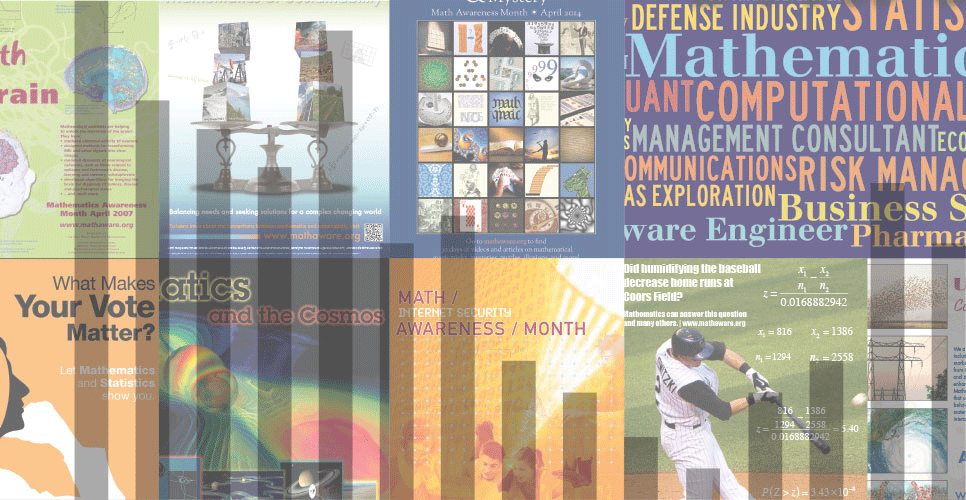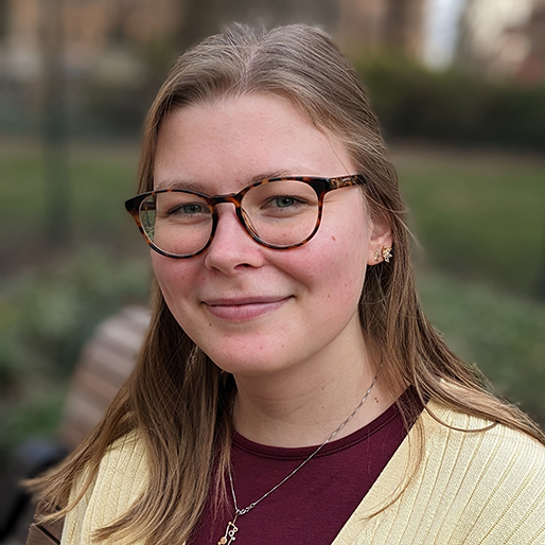SIAM Celebrates Mathematics and Statistics Awareness Month
April is Mathematics and Statistics Awareness Month! Each year, the Joint Policy Board for Mathematics—a collaboration between SIAM, the American Mathematical Society, the American Statistical Association, and the Mathematical Association of America—holds a month-long celebration to enhance public understanding and appreciation of mathematics and statistics. Both subjects have real-world societal impacts in nearly every imaginable field, such as medicine, biotechnology, energy, manufacturing, and business. Throughout the month of April, universities, high schools, student groups, research institutions, public information offices, and other related organizations host math-related activities. These activities often include workshops, competitions, departmental open houses, festivals, lectures, art exhibits, poetry readings, and other events centered around themes related to mathematics and statistics. Due to the ongoing pandemic, participants are encouraged to celebrate virtually this year and use the hashtag #MathStatMonth on social media to share their festivities.

Mathematics and Statistics Awareness Month originated in 1986 as Mathematics Awareness Week under then-U.S. president Ronald Reagan, who noted that enrollment in U.S. mathematical programs was declining. Mathematics Awareness Week initially focused on national-level events, such as a mathematics exhibit at the Smithsonian Institution and a reception on Capitol Hill. It became Mathematics Awareness Month in 1999 and began to shift its emphasis towards local, state, and regional activities. In 2017, the name changed to Mathematics and Statistics Awareness Month to recognize important research in both fields. Though the number and breadth of celebrations have grown throughout the years, the event has remained dedicated to increasing the visibility of mathematical and statistical research across a wide audience.
University department chairs, high school teachers, public policy representatives, and other professional leaders can access and share resources that help educate the public about the importance of mathematics and statistics in ongoing scenarios like sustainability, internet security, disease, and climate change. Mathematical and statistical research drives technological innovation and leads to discoveries of broad societal importance across many scientific fields. Here, several members of the SIAM News Editorial Board detail the ways in which they utilize mathematics to solve engaging problems.
Hans Kaper (Georgetown University), editor-in-chief of SIAM News: “I am an applied mathematician by training and profession, and my interests lie in the mathematical modeling of natural phenomena. Mathematical modeling combines the laws of nature with observational data and expresses them into the language of mathematics. A mathematical model is an abstraction; it reflects reality but should not be thought of as “reality.” It reveals the essential mechanism that drives the phenomenon of interest and allows us to explore various scenarios, whether theoretically or computationally.
Among the natural phenomena that have fascinated me in the past are reaction-diffusion phenomena in combustion systems, vortex formation and transport in high-temperature superconductors, and pattern formation in magnetic materials. I have recently become interested in climate issues and modeling the effects of human activities on Earth’s climate system. Some of my current work is related to the dynamics of glacial cycles during the Pleistocene, problems that concern food systems and food security, and mathematical approaches to resilience.”
Korana Burke (University of California, Davis): “Anyone who has tried to enter or exit a massive lecture room, music hall, or other large venue has likely been stuck in a crowd. This scenario is not a pleasant feeling in the best of times, and the ongoing pandemic has taught us that it can even be a health hazard. We can utilize differential equations to model the way in which people adjust their movements when they are in a crowd. These models allow us to study the appearance of bottlenecks and also their resolution. The results can generate more efficient entering and exiting protocols for existing venues and lead to the design of new venues whose geometry and seating arrangements would minimize bottlenecks and the resulting crowds.”
Oana Marin (Argonne National Laboratory): “Differential calculus revolutionized mathematical physics at the end of the 17th century. Almost two centuries later, computers have provided a platform for the simulation of any differential equation. Although the progress of science may now seem boundless, the expectations have shifted. We wish to explore all of the physical scales, we hope to simulate physical reality in real time on our mobile phones, and we want computers to teach us everything that we cannot analytically derive ourselves. Nowadays, we are disappointed to discover that the numerical methods we use to represent the physics on a computer are limited; computers themselves are not as reliable as forethought because of computational round-offs, sophisticated heterogeneous supercomputers, and so forth. The work of numerical analysts is almost akin to revisiting the days of Gottfried Wilhelm Leibniz and Isaac Newton, but this time equipped with a great weapon: the supercomputer.”
Lois Curfman McInnes (Argonne National Laboratory): “Computational science and engineering (CSE)—which unites mathematics and statistics, computer science, and core disciplines from the sciences and engineering—is actively transforming discovery and innovation in essentially all areas of science, engineering, technology, and society. CSE has become the essential driving force for scientific progress when classical experiments or conventional theory reach their limits, and in applications where experimental approaches are too costly, slow, dangerous, or impossible. Advanced mathematics-based computing is actively inspiring a wide range of scientific discoveries, better designs for new products, and support for decision-makers. Next-generation opportunities are moving beyond interpretive simulations and toward predictive science.”
Ali Pinar (Sandia National Laboratories): “I have been part of many interdisciplinary efforts throughout my career. In all cases, mathematics has been the common language that enabled communication between different disciplines. And the success of introducing rigor to a new area has been directly proportional to the ability to adopt mathematics.”
Rosemary Renaut (Arizona State University): “These days, my research involves the solution of inverse problems. I like to use the example of a speed camera that reads your license plate. The camera obtains a blurred version of the plate, but mathematics is at play in generating the letter that comes with the ticket by restoring the image from its blurred form. More complicated inverse problems surround us in many fields. For instance, consider medical images from PET and MRI scanners that assist with the diagnosis of various complications. Mathematicians have again been pivotal in the design of robust and accurate approaches that reconstruct the images from measurements that engineers and physicists cleverly obtain. We are not just “number people” — far from it. We are engaged in exciting problems with huge societal relevance that motivate our current research directions.”
SIAM encourages its members to partake in Mathematics and Statistics Awareness Month (MASAM) and proudly share the importance, beauty, and applicability of their research with the general public.
Interested in learning more? Check out these nine facts about mathematics, statistics, and MASAM!
About the Author
Jillian Kunze
Master's student, Drexel University
Jillian Kunze is the former associate editor of SIAM News. She is currently a master’s student in data science at Drexel University.

Stay Up-to-Date with Email Alerts
Sign up for our monthly newsletter and emails about other topics of your choosing.



